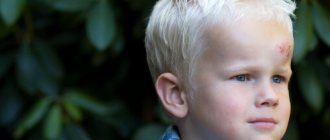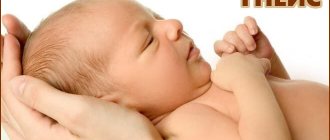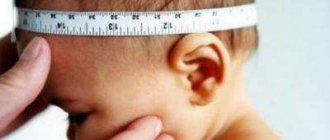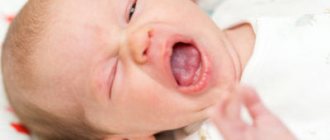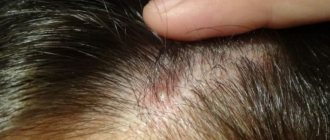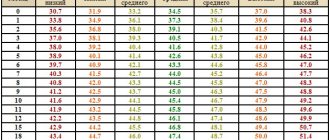A child has a lump on the head under the skin in the form of a ball: photo, what could it be on the back of the head or behind?
Finding a lump on the head of a baby who has just been born or an older child can greatly alarm parents.
Despite the fact that in such a situation there is often no reason to fear for the health of the baby, the swelling cannot be ignored.
What can cause a bump to form on the head of a newborn immediately after birth or in an older child? Which doctor should I go to with this problem and how to solve it?
Causes of a bump on the head
If you find a lump on a child’s head, you should not panic - this phenomenon, as a rule, does not threaten the baby’s life (we recommend reading: a child has a lump on his forehead: causes of formation and methods of elimination).
However, regardless of whether the lump is small or large, hard or soft, whether it is one or two, located under the skin or on its surface, on the back of the head or on the crown, it is recommended to show the baby to a doctor in any case.
Immediate medical attention is required if:
- a lump was discovered on the skull of a newborn baby;
- the size or number of formations increases;
- the lumps or surrounding areas of the skin have become bright red;
- the child complains of pain in the area of the lump;
- when pressing on the tumor, the baby cries loudly and turns its head;
- body temperature rises;
- when pressed, a watery liquid is released from the formation;
- no appetite;
- sleep and wakefulness patterns are disrupted;
- The baby became capricious and restless.
In a newborn baby
It is not uncommon for newborn babies to develop small balls on the top or back of the head. As a rule, they are not dangerous to the health of the baby. Most likely, in this case we are talking about an injury he received during childbirth. childbirth is a very traumatic procedure not only for the woman, but also for the fetus.
pressure drop during labor, narrow pelvic bones of the woman in labor, impact as a result of inaccurate use of surgical instruments - these factors can cause a lump to appear on the baby’s head from the back or front. As a rule, the bruise goes away on its own within 2–3 days and does not require special measures.
If the baby's lump has not disappeared after 14 days from the date of birth, you should immediately consult a doctor. in this situation, surgery will most likely be required.
in exceptional cases, the cause of the formation of a lump in newborn babies immediately after birth is poor blood clotting. in this case, a blood bubble forms on the baby’s head.
in this situation, immediate application of therapeutic measures is necessary.
as a result of impact
If a lump-shaped lump appears on the child’s head, it can be assumed that it arose as a result of a mechanical injury.
Babies over 1 year old who can already walk are very active and, due to clumsiness, often fall. If you don't keep an eye on the baby, he may hit his head on a hard object.
When struck or bruised, the soft tissues swell, which causes a lump to appear, and subsequently a lump.
in older children, such formations may appear during outdoor games with peers or active sports. the bruised area swells, turns red and becomes very painful.
If immediately after injury you apply a cold compress to the affected area of the skin for 20–25 minutes, this will quickly restore damaged tissue.
in cases where the lump does not go away on its own within a few days, and the child complains of a constant headache, you should urgently show him to a doctor. in this case, we can talk about a concussion.
read also: Which doctors should a child be examined by at 6 months?
When an infant’s head is injured, it is recommended in any case to take him to a specialist, especially if he cries for a long time after the blow. You must make sure that the baby did not damage the bone during the fall.
non-traumatic reasons
The reasons for the appearance of a bump on a child’s head of a non-traumatic nature include the following:
- benign neoplasms. tubercles may also indicate benign tissue growth: atheroma, lipoma or fibroma (parents often diagnose by photo). They differ from malignant neoplasms in that they move freely under the skin during palpation, have a dense consistency and clear outline, and do not cause pain when touched. atheroma is formed as a result of blockage of the sebaceous gland duct. Most often, such cysts appear on areas of the body covered with hair, especially on the head and neck. such a neoplasm can degenerate into a malignant tumor over time. lipoma (fat) appears in areas of the body with little fatty tissue. cases of its degeneration into cancer are not known to medicine, so it does not require mandatory elimination. Excess fibrous connective tissue is called fibroma. its transformation into cancer is practically excluded, especially if it is located on the skin. As a rule, only those types of compaction that are located on the mucous membranes are subject to degeneration.
- inflammation of the lymph nodes. The enlargement of lymph nodes is facilitated by a decrease in the body's defenses. Moreover, immunity does not always decrease with the onset of the cold season - this phenomenon can be observed in children even in summer in hot weather. In most cases, swollen lymph nodes do not cause pain to the child, so they are quite difficult to detect. The seals on the occipital region and behind the ears are especially invisible in infants of the newborn period, since in babies of this age the lymph nodes are very difficult to palpate (see also: why can the occipital lymph node in a child be enlarged?). bumps can appear on the head on one side or be located symmetrically.
- parotitis. This disease is characterized by inflammation of the salivary glands, which manifests itself in the form of a small ball near the ear. subsequently the earlobes and cheeks swell. In addition to these signs, mumps is characterized by severe pain during swallowing and chewing food, hyperthermic syndrome, muscle pain, migraine, feverish chills, refusal to eat, drying out of the salivary glands, and inflammation of the testicles in boys.
how to treat a bump on a child's head?
The method for eliminating a lump depends on the reason for which it appeared. The atheroma is removed using a laser, dissection and subsequent enucleation, as well as making two bordering incisions and pulling it out with scissors. Wen should be removed only in cases where they are located in areas of the body that are subject to constant friction.
Mumps cannot be treated at home. Therapy in this case involves complete isolation of the sick patient.
Since modern medicine does not have specific methods for getting rid of mumps, the main goal pursued in treating the disease is to prevent the development of complications in the form of damage to the digestive system, inflammation of the genital organs and loss of reproductive function.
If a lump appears on the head as a result of a bruise, first aid involves:
- applying ice or other items from the freezer - they must first be wrapped in a piece of clean cloth;
- the use of decongestant ointments and gels (“Traumel”, “Rescuer”, “Aibolit”, “Troxevasin”, “Troxerutin”);
- using a compress with a piece of sterile gauze soaked in vegetable oil;
- temporary bed rest, as well as a ban on outdoor games and active sports.
What to do if the lump does not go away for a long time and gets bigger, which doctor should I go to?
If you suspect a pathology, you should immediately show the baby to a doctor. The initial examination is carried out by a pediatrician. In addition, you may need to consult with specialized specialists:
- surgeon - in cases where the appearance of a lump was provoked by benign neoplasms, warts and suppurations that appeared against the background of enlarged lymph nodes;
- oncologist - if there is a suspicion of formations that can degenerate into cancerous tumors;
- otolaryngologist - with pronounced signs of lymphadenitis.
To clarify the clinical picture, the doctor may refer the child to donate blood and urine for analysis, conduct a tumor marker, radiography and ultrasound. Based on the results of these examinations, a treatment plan is developed.
Source: https://www.deti34.ru/simptomy/golova-sheya/shishka-na-zatylke-u-rebenka.html
Reasons for the appearance of hard and soft bumps on the head in a child under one year old
Children rarely go without scratches and abrasions. Little fidgets, trying to be on time always and everywhere, often fall, hit themselves, and get bruises. A lump on a child's head can cause great concern. This phenomenon cannot be ignored. The lump does not always appear from a blow; it can be a symptom of a serious illness.
Bumps on the head of children are a common occurrence.
Why does a child have a bump on his head?
Parents who find a lump on the back of their child’s head are advised to know that this is not always a consequence of a blow. There are many reasons for the occurrence of neoplasms.
Insect bites
During insect activity in spring and summer, bumps often appear as a result of bites. Most often they do not pose a danger, but they cause discomfort. The site of inflammation may hurt, redness appears, and the child is bothered by itching. The seal goes away on its own after a few days.
As a result of the impact
A bump on the top of a child's head is often formed as a result of a fall or blow from something hard on top. While playing, the baby may hurt his head. Due to mechanical damage, a hematoma forms.
It may vary in color. When pressed, a sharp pain occurs.
The formation takes place on its own; to speed up the process, the doctor may recommend anointing it with special ointments or creams.
If a soft tissue bruise occurs, then most often the tubercle subsides within a few hours. The appearance of a hematoma indicates that the vascular area is damaged.
Important! Be sure to consult a doctor if a lump occurs after a bruise. A neoplasm can be very dangerous. If there is a crack in the skull, severe bleeding may occur.
Parents can provide first aid before the damage is examined by a specialist. To do this, apply ice to the area of impact and make a cold compress from any cloth moistened with cold water.
If there is nothing cold, you can apply a cotton swab treated with vegetable oil to the bruised area. The doctor may prescribe medications to resolve the hematoma, prevent thrombosis, and relieve swelling.
It is important to rule out a concussion.
If you fall, you need to ensure rest before being examined by a doctor, and it is important not to let the child fall asleep. This is necessary to control his condition.
Often, hematomas in the head area occur due to blows
The lymph nodes
Large lumps on a child's throat that extend into part of the head may appear as a result of inflammation of the lymph nodes. The seals are easily palpable and visible visually. They can form not only near the head and neck, but also in the armpits.
The disease can occur either independently or as a result of an infectious pathology, for example, chickenpox. The child may develop additional symptoms such as fever, loss of appetite, and lethargy. When you touch the lump, pain is felt. If treatment is not started in a timely manner, the inflammation may turn purulent.
Lipoma (wen)
This is a type of benign tumor that forms from adipose tissue. It does not cause inconvenience because it does not hurt. When pressed, the tubercle is mobile and soft.
The causes of lipoma may be hormonal imbalance, stroke, or problems with fat metabolism.
It is necessary to treat a lipoma only if it grows strongly, as it can begin to compress adjacent skin tissues.
Other reasons
Often, mothers of newborns discover a soft lump on a child’s head. This is a hematoma that occurs as a result of mechanical trauma during the birth process. Damage can be caused by instruments used by medical personnel. It is most pronounced in the first month of the baby’s life. Most often, the neoplasm disappears completely within a year.
A lump in a child may occur as an allergic reaction. For example, after vaccination with DPT, lumps form on the legs of babies. Therefore, after any injection, vaccination or taking a new drug, it is important to look at the baby’s reaction.
Neoplasms can often be seen in newborns as a result of injury during childbirth
Associated symptoms
Rash on the face and head of a newborn - what is it?
If an occipital neoplasm does not go away on its own over a long period of time, it is necessary to show the child to a doctor. Often at such moments additional symptoms appear:
- rapid heartbeat, parents can control it themselves by placing a finger on their wrist;
- pale skin;
- long-term pain in the area of inflammation;
- the size of the pupils changes;
- there is a violation of coordination of movements, orientation in space;
- general weakness, dizziness, nausea, vomiting;
- heaviness when turning the head.
The child may be bothered by severe headaches that occur with increasing intensity, and loss of appetite. If at least one of the listed signs appears, you must immediately call an ambulance. Their presence indicates the development of severe pathology. Often, the success of treatment depends on how long after the tumor occurred the parents sought qualified help.
Diagnosis of pathology
During the initial examination, based on appearance and size, the doctor can guess the factors that caused the formation of a bulge on the baby’s head. The main criteria that the specialist focuses on during the examination are:
- number of neoplasms;
- size;
- location;
- color;
- general condition of the child.
Wen on the face of a newborn, on the nose, on the head - what is it?
To make an accurate diagnosis, the baby is prescribed:
- general blood and urine tests that will show whether there is an inflammatory process in the body;
- MRI, CT.
Based on the results of the examination, a diagnosis is made and, if necessary, treatment is prescribed.
Important! You cannot try to self-medicate or apply folk remedies to emerging formations. All appointments should be made only by a specialist.
Laboratory tests are ordered to determine the cause.
When to see a doctor immediately
Peeling skin on a baby's head - what to do
You should immediately consult a doctor if a bump on your child’s head appears as a result of injury or mechanical damage. If the baby’s condition worsens sharply, the following symptoms will occur:
- the appearance of drowsiness;
- severe dizziness;
- pale skin;
- the occurrence of seizures.
Important! In such a situation, parents should call an ambulance. Before the doctors arrive, provide the child with complete rest by placing him on his side.
If a child is bothered by a severe headache, nausea, vomiting and weakness, it is necessary to urgently call an ambulance
Which doctor should I contact?
If a lump has formed on the back of a child’s head, it does not go away for a long time and is accompanied by additional symptoms, you should consult a doctor. The initial examination is carried out by a pediatrician, he will prescribe tests and give a referral, if necessary, to a specialist. An accurate diagnosis may require examination by an ENT specialist, a surgeon and an allergist.
A child has a lump under the skin on his head - what could it be?
Childhood is a wonderful time, you can play and fool around, ride a bike and climb trees. Of course, most fun games don't come without bruises, scrapes and bumps. What to do if a child falls and hits his head? Or you found a bump on the head, but the baby did not fall. Should I worry and when should I consult a doctor?
Why might a bump appear on your head?
Bumps on the head appear for various reasons. Most often this is mechanical damage, the result of a blow or insect bite. This lump appears very quickly because tissue swelling occurs. It is painful, but goes away on its own over time.
In all other cases, the lump should definitely be shown to a doctor; treatment or observation is necessary. Possible reasons for the appearance of a lump:
- neoplasm (atheroma, fibroma, hemangioma, lipoma);
- inflammatory process (enlarged lymph nodes, ulcers);
- congenital pathology (cephalohematoma).
Types of pathologies with symptoms
The main types of bumps on a child’s head:
- Hemangioma is a small red lump, consists of clots of blood vessels, grows with the child, and can affect neighboring tissues. Occurs in newborns or appears in the first months of life and requires constant monitoring. More often girls are born with hemangiomas, but boys also have them. On the head they are usually localized in the eye area or behind the ears. If the hemangioma continues to grow, it requires treatment. If in the first year of life it does not increase in size, then it goes away without treatment by 10-12 years.
- Lipoma or wen. In itself, it is harmless, easily mobile, and grows slowly. If it causes discomfort, you can remove it.
- Atheroma is a blockage of the sebaceous gland (sebaceous gland cyst). It often grows and reaches impressive sizes. It is removed surgically. Usually located at the back of the head under the hairline. It is usually not painful, but when infected, it becomes inflamed, causing discomfort and pain.
- Fibroma is a hard, benign tumor. To determine the nature, it is necessary to consult an oncologist and undergo tests.
- A wart is a small flesh-colored or brown lump, usually under the hair. The cause of the appearance is unknown, perhaps due to decreased immunity or heredity.
- Enlarged lymph nodes. Often this happens on both sides simultaneously - symmetrical bumps form behind the ears.
The baby may have a birth injury or cephalohematoma. This is a small tumor on the occipital region. On palpation, liquid is felt inside.
It requires only observation and by the age of two weeks it completely goes away on its own. Concerns arise when the swelling grows, turns red, or produces fluid.
You should immediately consult a doctor and take action, as an increase in formation can be life-threatening.
Cephalohematoma on the head of a newborn
Bumps on a child’s forehead are simply an individual anatomical feature of the structure of the skull (more details in the article: what to do if a bump appears on a child’s forehead?). They are not a pathology and do not require special treatment. Don’t worry if a child is born with such a lump - by the age of two months, with proper care, everything disappears without consequences.
Which doctor should I see?
The children's clinic will refer you to a surgeon. If the clinical picture is insufficient to make an accurate diagnosis, consultations with an oncologist, allergist, ENT specialist, as well as the results of various tests and additional examination will be required. The bulk of such diagnoses is within the competence of the surgeon; it is he who will undergo further examination and observation.
Diagnosis of pathology
Birth injuries are not uncommon. The bones of the skull are subject to enormous stress as they pass through the birth canal. The newborn is carefully examined by a neonatologist, who diagnoses pathology if it is present. To clarify the diagnosis of cephalohematoma, ultrasound, head x-ray and other examinations are performed (we recommend reading: at what age can a child have an x-ray of the head?).
Ultrasonography
After childbirth and discharge from the hospital, monitoring the child’s condition is the mother’s concern. Balls and small bumps under the skin are easy to spot during daily hygiene. The baby's skull is very soft, the fontanel is not yet closed, it is important to avoid injuries and bruises (more details in the article: in how many months on average does the fontanel in infants close?).
It is easiest to identify a hemangioma by its appearance and characteristic red color. In the future, the surgeon should monitor it, monitor its growth and dynamics.
If you find a ball-shaped lump on the back of a child’s head after a bruise, it is better to immediately show it to the doctor. The main criteria that the doctor focuses on during the examination:
- size;
- number of cones;
- location;
- color;
- amount of blood leaked (in case of injury);
- general condition of the patient.
By comparing all the parameters and assessing the possible risk of damage or danger to the brain, the doctor will make an accurate diagnosis. Only with light blows can you do it yourself.
Treatment options
Blows and bites do not require treatment. If necessary, you can alleviate the suffering by briefly applying ice wrapped in a soft cloth. An antihistamine will relieve itching and swelling from a bite. If the blow is not severe, you can treat the damaged area with a special ointment that relieves swelling.
Cases when you need to see a doctor:
- Cephalohematoma after childbirth. In most cases, the watery bump on the top of the head will disappear on its own over time. If this does not happen, a puncture is used - the doctor uses special needles to pump out the liquid from the lump.
- How to treat one small bump on the head that did not appear as a result of a blow? Atheromas, fibromas or warts may be located on the back of the head. This case often requires surgery.
- Enlarged lymph nodes are often the result of a recent illness (angina, infectious mononucleosis, tonsillitis, inflammation of the adenoids) (we recommend reading: enlarged lymph nodes in a child’s neck: symptoms and treatment). Inflammation of the lymph nodes can be combated only by identifying the source of the disease. It is possible to use antibacterial or immunostimulating agents. As a last resort, surgery is indicated.
- Wen on the head is removed using cryodestruction. This treatment is effective and virtually painless.
If the lump requires surgical removal due to the nature of the tumor or for aesthetic reasons, the operation is performed in a hospital. Sometimes a laser is used (hemangiomas, warts). Recovery occurs within a week.
Lumps that appear as a result of severe injuries require immediate medical attention. The following symptoms will indicate the seriousness of the situation:
- a sharp deterioration in health;
- dizziness and severe drowsiness;
- cramps in the limbs;
- constriction or dilation of the pupils;
- severe pallor of the skin;
- heavy bleeding from the wound;
- muscle paralysis.
Parents need to call a team of doctors, and until they arrive, place the child on his side and ensure peace. This position will prevent the child from choking if vomiting begins.
Interesting:
Share with friends on social networks
Source: https://baby-bob.ru/u-rebenka-na-golove-obrazovalas-shishka-pod-kozhey-chto-eto-mozhet-byt/
A lump on a child’s head - what it could be and how to get rid of it at home
If you have a child in your family, then various types of injuries will be common, because children are very active and mobile. Often the result of an unfortunate fall is a bump. But the presence of a hematoma can also be caused by other reasons. Often a hematoma can be found by examining the head of an infant.
In this article we will look at the main reasons for the formation of bumps in children and the measures that parents need to take.
The concept of a bump as a type of head injury
During an impact, capillaries and blood vessels are damaged. There is no fatty layer on a child’s head, as a result of which blood flows out and accumulates between the soft tissues and the skull.
A swelling is formed, which is called a lump. As you can see in the photo of the bump on the baby’s head, its size is affected by the volume of blood that has leaked out.
Bump after a bad fall
A bump on a child’s head forms immediately after a blow from a fall. The reason for its formation is damage to the soft tissue that is adjacent to the skull, resulting in rupture of blood vessels and the formation of swelling. Timely actions can prevent swelling from growing.
What to do if a child hits his head and a bump pops out? Cold should be applied to the injured area as quickly as possible.
But it is worth remembering that such manipulation must be done through a scarf or cloth to avoid frostbite of the skin.
Permitted use:
- ice from the freezer;
- cloth soaked in cold water;
- special gel pad;
- frozen butter, fish, meat;
- plastic or glass bottle with cold water;
- rubber container with ice.
The larger the bruise, the longer the period of contact of the cold thing with the skin should be. The next day, exposure to heat is effective. It reduces the degree of swelling and reduces swelling.
The compress is not applied if the skin has been damaged and an open wound has formed. In such a case, you need to disinfect the injury site and consult a doctor.
But often parents do not see the moment of the fall and, accordingly, cannot provide first aid immediately. If your baby complains of pain at the site of the impact, you can lubricate the bruise with some medicine.
How to anoint a bump on a child’s head? Products like Rescuer ointment, Sinyakoff ointment, etc. are suitable. Usually after two to three days the lump goes away on its own. However, if the hematoma does not disappear for a long time and hurts, then you should definitely consult a doctor.
Remember, the younger your child, the greater the danger of head injuries. A blow to the lateral and parietal region of the head and the back of the head can be quite serious. In such a situation, you need to consult a doctor for medical help.
There are other situations that require calling a doctor:
- the pain does not subside after 15 minutes. after the fall;
- the child is feeling sick;
- loss of consciousness by the baby;
- convulsive movements;
- the skin does not return to its natural shade an hour after the injury;
- loss of orientation in space;
- increased drowsiness immediately after a fall;
- change in pupil size;
- inability to make movements, including with the head;
- bleeding from the ears.
It should be remembered that the conditions described above may not occur immediately, but during the first day after the impact. As a result, the baby needs close attention from his parents at least during the first day after the fall.
Other reasons for the formation of a lump in a child
Swelling on the head is not always a consequence of injury. Some pathological abnormalities can also cause the formation of hematomas.
Sometimes parents may find a lump on the back of their child's head. Most often this is an enlarged lymph node. The reason for the increase may be a previous illness, decreased immunity, or adaptation of the child’s body to a new environment (in newborns).
In any case, you need to go to the clinic with your child. The doctor will accurately determine the cause and prescribe appropriate medications and procedures.
A soft bump on a child’s head requires careful attention. But there is no need to panic ahead of time. Observe the baby’s behavior, provide the necessary assistance in a timely and correct manner, and, if possible, consult a doctor for advice.
Photo of a bump on a child's head
Help the project, tell your friends:
Source: https://detkiexpert.ru/shishka-na-golove-u-rebenka/
Tumor on the head in the form of a lump: types, why it appeared, symptoms, consequences, treatment
The appearance of a bump on the scalp is not immediately noticed; only when it reaches a fairly decent size does it reveal itself. Tumors differ depending on the type. They can be soft or hard to the touch. The location can be different: on the back of the head, on the forehead, on the temporal part.
Kinds
There are several types of cones:
- Lipoma, its other name is wen. The lump grows quite slowly, there is no pain during palpation, there is a mass in the form of fat inside.
- Papilloma is a benign formation. It can be on a leg or flat. On palpation, as a rule, there is no pain. The surface is loose and can be long or oblong. In older people, warts are often flat, brown, gray or even black.
- Hemangioma is a benign formation that occurs in children immediately from birth. Its surface is red, loose, loose, painless.
- Osteoma is a benign neoplasm that develops from the bone tissue of the skull; accordingly, it is hard to the touch and does not hurt.
- Atheroma is a cyst that begins to grow in place of the sebaceous gland, making it difficult for its secretion to escape. Inside the neoplasm there is sebaceous content, upon palpation pain occurs, and it tends to periodically become inflamed.
- Trichoepithelioma is a benign, small tumor. It develops at the site of the hair follicle. Soft to the touch, painless. The reason for its formation is hereditary predisposition. Multiple formations are often encountered.
- Fibroma is a benign type of tumor that develops from connective tissue and is similar in appearance to a wart. Doesn't hurt when touched.
- Sarcofibroma is a cancerous neoplasm that grows quite quickly from connective tissue, the boundaries are unclear. When palpated, it resembles a knot in the skin covering.
- A furuncle is a purulent formation.
Causes
The reasons are divided into internal and external.
Trauma, bruise
This factor is considered the most common in medical practice. After the blow, swelling occurs in the form of a lump. It is often painful on palpation. A simple bump does not require treatment and goes away on its own; to quickly disappear, you need to apply a cold compress immediately after the blow.
However, if after the blow a person loses consciousness or develops nausea or dizziness, this may indicate a closed head injury. In this case, the brain tissue is directly damaged, and the lump is just an external sign of a dangerous indicator.
If you experience the above symptoms, you should immediately consult a doctor to make sure there is no severe brain damage or bleeding. An MRI or CT scan will be necessary to determine how serious the injury is.
A bite of an insect
Manifests itself as an allergic reaction. The size of the resulting lump can vary from 5 mm to several centimeters, it depends on the severity of the allergy. In this case, anti-allergy medications will help; an examination by an allergist is advisable.
Atheroma
A lump that is painful to the touch develops due to a blockage of the sebaceous gland, making it difficult for its contents to exit. It grows quickly, often being larger than a chicken egg. Most often seen in the back of the head.
If there is damage to the integrity of the skin, there is a high risk of bacteria getting inside, which causes the development of purulent inflammation. In this case, the body temperature increases, and a tugging pain appears in the area of the lump. It is treated exclusively by surgery.
Hemangioma
The formation occurs as a result of an abnormality in the structure of the blood vessels located under the skin. Forms a bulge that looks like a button.
With its rapid growth, it invades healthy cells, which makes it very dangerous. They are most often located behind the ears and in the eye area. If they appear, you should immediately visit a doctor.
Fibroma (sarcofibroma)
A benign tumor that is hard to the touch. However, in order to make sure that this tumor is really a fibroma and not a malignant formation, it is necessary to undergo tests and seek advice from an oncologist.
The reasons for its occurrence are still not fully understood. Some believe that it can appear in anyone, others believe that it is a hereditary pathology, and others believe that it is due to various skin lesions.
Furuncle
A tumor with a reddish tint and a white-greenish purulent head. Purulent formation occurs due to infrequent hair washing, hypothermia, use of low-quality cosmetics, as well as when bacteria are introduced through minor skin lesions (often due to careless combing).
Lipoma
Formed as a result of repeated trauma, it does not cause any discomfort and is an accumulation of fat cells in one place. Lipoma is absolutely safe, but it becomes necessary to consult a doctor if it is large in size, as well as if it is swollen and compresses blood vessels. It is formed due to pathologies in adipose tissue, poor heredity and metabolic disorders.
Wart
When large in size, it resembles a lump and is often found on the scalp. Usually, after an examination, a good doctor can accurately indicate the cause of its occurrence, most often it is a sharp decrease in immunity.
Medications can be used for therapy; burning with laser, liquid nitrogen; surgical removal.
Symptoms
Symptoms are determined depending on the type of formation.
Injury
Painful sensations appear when pressed, redness and swelling occur. With more serious injuries, which indicate a closed craniocerebral injury, the following symptoms occur:
- Loss of consciousness occurs immediately after the injury. At this time, the patient does not respond to external stimuli and does not feel pain.
- Pain in different parts of the head - begins immediately after regaining consciousness.
- Nausea and vomiting do not give a feeling of relief.
- Dizziness.
- Hematoma - most often occurs with fractures of the bone frame of the skull. You can often observe the ear and near the eyes.
- The face and neck become red.
- Amnesia - a person does not remember events that happened before the injury (occasionally there are cases when a person forgets events that happened after the injury).
- Development of convulsive syndrome.
- Increased sweating.
If the vessels of the brain are damaged, then hemorrhage in the membranes is possible. This situation is manifested by the following symptoms:
- Sudden pain .
- Photophobia is pain in the eyes in bright light.
- Vomiting and nausea that do not make you feel better.
- Loss of consciousness.
- The muscles of the back of the head are tense, it is impossible to bring the chin to the chest.
Insect bites
With insect bites, sometimes there are no symptoms, but if they are present, immediately after the bite a person may experience itching, swelling, pain, and an increase in temperature. All these symptoms can last up to several days, the pain gradually decreases.
The lump itself is an allergy to insect venom. On palpation, this formation is solid, marked in the center with a red dot, as if pricked by a needle (the site of an insect bite).
Fibroma
Fibroma is a hard formation to the touch that is painless. The danger appears when it occurs on the scalp, as it can be injured when combed and become infected.
Diagnostics
Each tumor is diagnosed differently.
For traumatic brain injury, X-rays, MRI and CT are used, and angiography is often performed (examination of brain vessels with the introduction of contrast agents).
Insect bites are diagnosed based on clinical manifestations. Treated by an allergist.
Confirmation of atheroma begins with examination and palpation of the atheroma itself and nearby lymph nodes. Next, Doppler ultrasound, ultrasound of the cyst, CT scan, and head x-ray are prescribed. The most accurate method is histological examination.
Hemangioma is diagnosed in the following ways:
- general blood
- Ultrasound of the brain.
- Endoscopic studies.
- Magnetic resonance imaging.
- Multislice computed tomography.
The fibroid is examined by a doctor. Additionally, histological and cytological tests are prescribed.
Diagnosis of hemangioma is carried out by a dermatologist. For this purpose, ultrasound, biopsy and cytological examination are prescribed.
Confirming the presence of warts involves scraping and examining them using a microscope. If a malignant tumor is suspected, a biopsy is prescribed.
Treatment
Treatment for the resulting lumps depends on the type and cause.
First aid for injury is to apply a cold compress to the injury site (frozen foods are often used for this). Keep for about 10 minutes. Preparations in the form of ointments and gels are also used:
- Troxevasin – strengthens vascular walls, relieves swelling. Rub in gently twice a day.
- Troxerutin - effectively eliminates swelling; it is forbidden to apply to injuries where the integrity of the skin is compromised.
- Heparin ointment - relieves pain and resolves blood clots.
- Rescuer - antiseptic effect.
If insect bites occur, treat with soap and cold; if symptoms persist, use anti-allergenic agents. If necessary, consult an allergist or dermatologist.
For lipoma, self-treatment is not carried out; the help of a surgeon is required. Most often it is removed surgically, with a laser, or using a special substance that resolves fat (injected into the wen itself).
For atheroma, the use of various ointments and folk remedies turns out to be ineffective; they are best used for faster healing after removal or self-opening of the tumor. Removal of atheroma is carried out surgically, laser and radio wave methods.
Treatment for fibroids is primarily aimed at eliminating the cause. Next, the tumor is removed using a laser, surgery, cryodestruction (using low temperatures) or radio wave method.
There are several ways to remove a hemangioma:
- Application of liquid nitrogen (no traces are left).
- Microwave cryodestruction – for deep facial tumor localization.
- Radiation therapy – for damage near the eye.
Therapy is carried out exclusively under the supervision of a doctor, since the risk of transformation into a malignant tumor is high.
The boil is removed by a surgeon on an outpatient basis, after which antibacterial and physical therapy is prescribed.
The most effective way to remove a wart is to remove:
- Current therapy is not the most effective method; several sessions are often necessary.
- Freezing with nitrogen is expensive and the surgery leaves visible scars. Long-term postoperative care is also necessary.
- Laser burning is the most widely used procedure and is carried out quickly. No traces remain and similar neoplasms no longer appear.
- Surgical intervention.
Consequences and complications
Whether there will be consequences depends on the extent, type of damage and timeliness of treatment.
Minor bruises usually resolve without complications. Severe ones may in the future affect vision, motor function, mental activity and regular headaches.
Insect bites are complicated by allergic reactions, and with a tick bite, infection with encephalitis and borreliosis is possible.
Boils can provoke meningitis, encephalitis, and cerebral vascular thrombosis. Lipoma can lead to mental and sleep disturbances.
Atheroma provokes the development of infection, which in turn causes relapses, phlegmon - the destruction of the purulent capsule and the spread of pus through the subcutaneous layer and into deeper layers. The most dangerous thing is transformation into a malignant tumor.
Fibroids also carry a risk of cancer. Hemangioma leads to ulcers, blood vessel diseases, external and internal hemorrhages.
In most cases, bumps are not very dangerous, especially painless ones. However, it is always better to consult a doctor to find out the cause and nature of the tumor, thereby eliminating possible complications.
Source: https://nevralgia.ru/opuholi/golovy-v-vide-shishki/
What to do if a child has a lump on the back of his head?
- Causes
- Symptoms
- Treatment methods
A lump is a subcutaneous neoplasm related to a benign tumor. If the defect appears as a result of mechanical damage, then it is not a tumor, but a bulge consisting of lymph and blood.
Parents of active children often notice that their child develops bumps only on the head, and on an arm or leg, even with strong blows, only a bruise. The fact is that when damage occurs to the extremities, blood and intercellular fluid are quickly distributed in the subcutaneous fatty tissue.
There is no such layer on the head, so after damage to the blood vessels, the blood has nowhere to go except to be localized between the skull and skin in the form of a lump.
